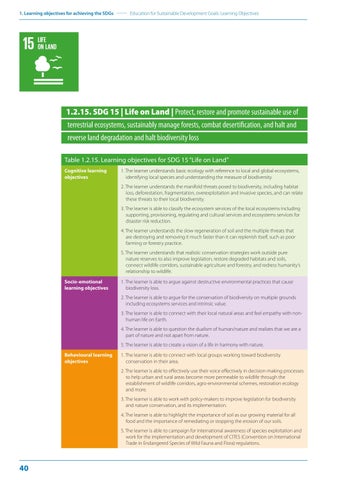1. Learning objectives for achieving the SDGs
Education for Sustainable Development Goals: Learning Objectives
1.2.15. SDG 15 | Life on Land | Protect, restore and promote sustainable use of terrestrial ecosystems, sustainably manage forests, combat desertification, and halt and reverse land degradation and halt biodiversity loss Table 1.2.15. Learning objectives for SDG 15 “Life on Land” Cognitive learning objectives
1. The learner understands basic ecology with reference to local and global ecosystems, identifying local species and understanding the measure of biodiversity. 2. The learner understands the manifold threats posed to biodiversity, including habitat loss, deforestation, fragmentation, overexploitation and invasive species, and can relate these threats to their local biodiversity. 3. The learner is able to classify the ecosystem services of the local ecosystems including supporting, provisioning, regulating and cultural services and ecosystems services for disaster risk reduction. 4. The learner understands the slow regeneration of soil and the multiple threats that are destroying and removing it much faster than it can replenish itself, such as poor farming or forestry practice. 5. The learner understands that realistic conservation strategies work outside pure nature reserves to also improve legislation, restore degraded habitats and soils, connect wildlife corridors, sustainable agriculture and forestry, and redress humanity’s relationship to wildlife.
Socio-emotional learning objectives
1. The learner is able to argue against destructive environmental practices that cause biodiversity loss. 2. The learner is able to argue for the conservation of biodiversity on multiple grounds including ecosystems services and intrinsic value. 3. The learner is able to connect with their local natural areas and feel empathy with nonhuman life on Earth. 4. The learner is able to question the dualism of human/nature and realizes that we are a part of nature and not apart from nature. 5. The learner is able to create a vision of a life in harmony with nature.
Behavioural learning objectives
1. The learner is able to connect with local groups working toward biodiversity conservation in their area. 2. The learner is able to effectively use their voice effectively in decision-making processes to help urban and rural areas become more permeable to wildlife through the establishment of wildlife corridors, agro-environmental schemes, restoration ecology and more. 3. The learner is able to work with policy-makers to improve legislation for biodiversity and nature conservation, and its implementation. 4. The learner is able to highlight the importance of soil as our growing material for all food and the importance of remediating or stopping the erosion of our soils. 5. The learner is able to campaign for international awareness of species exploitation and work for the implementation and development of CITES (Convention on International Trade in Endangered Species of Wild Fauna and Flora) regulations.
40


